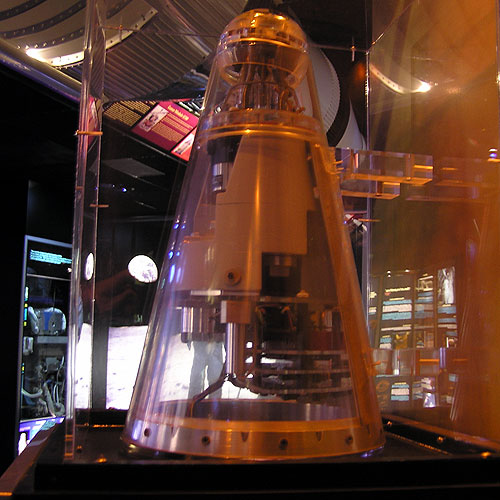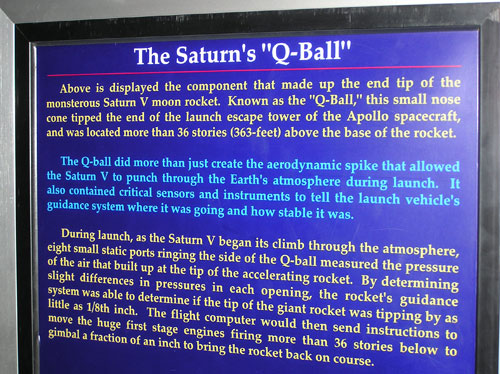|
|

|
|
Author
|
Topic: Saturn V Q-Ball cover (LES nose cone cap)
|
jasonelam
Member Posts: 691
From: Monticello, KY USA
Registered: Mar 2007
|
 posted 08-11-2008 12:08 PM
posted 08-11-2008 12:08 PM
   
I have noticed on some of the Saturn V launch videos that at about 15 seconds before launch there is a camera view showing a cap over the Launch Escape Tower's tip that gets pulled off by a cable link attached to it. Can anyone explain what the purpose of this was for? For those interested, it can mainly be seen in Apollo 15 televised launch coverage. |
butch wilks
Member Posts: 334
From: Lowestoft, Suffolk, UK
Registered: Mar 2007
|
 posted 08-11-2008 12:53 PM
posted 08-11-2008 12:53 PM
   
The cover at the top of the LES is for the Q-ball that is at the very tip of the LES.Most put the height of the Saturn V as 363 feet, but they do not add the 3.5" of the Q-ball as it goes in as the air pressure goes up, so sometimes it's 363 feet, sometimes it a bit more to a max of 363.3 feet in height. The cover keeps it a zero up the point of lift off. |
Robert Pearlman
Editor Posts: 43576
From: Houston, TX
Registered: Nov 1999
|
 posted 08-12-2008 09:42 AM
posted 08-12-2008 09:42 AM
   
From the Apollo 16 Flight Journal: -001:10 Public Affairs Officer: "This is Apollo Saturn Launch Control. T minus 1 hour, 10 minutes, 58 seconds and counting. At the 1 hour and 13 minute mark, scheduled with a Q-ball simulated command, this command goes to the Q-ball and is read out in the spacecraft by the spacecraft commander. The Q-ball is an angle of attack sphere perched above the launch escape system, and it's used to give the spacecraft commander and the crew any signals which would indicate an out of tolerance condition during the early stages of flight. The countdown [is] moving along well at this time. T minus 1 hour, 10 minutes, 25 seconds and counting. This is Kennedy Launch Control." [The Q-ball is not unlike a pitot tube on an aircraft that measures airspeed. It consists of eight openings at the top of the Launch Escape Tower. These openings lead to instruments which gauge air pressure. As well as providing dynamic pressure (known as "Q") information during powered flight, they help determine the angle of incidence of the tower during an abort event. The Q-ball design works at almost all air-speeds, unlike the pitot-static instruments used on most aircraft. A similar type of Q-ball was fitted to NASA's hypersonic X-15 research aircraft made, like the CSM, by North American in Downey, California. The Q-ball is covered until shortly before launch, to prevent blockage of the holes.] quote:
Originally posted by jasonelam:
For those interested, it can mainly be seen in Apollo 15 televised launch coverage.
You can see that footage online. And to quote Wikipedia: The Q-ball cover was split in half vertically and held together by a 2-inch (51 mm) rubber band. A razor blade was positioned behind the rubber band, pinched between the halves of the cover. A wire rope was connected to the top and bottom of the razor blade and to both halves of the cover. The wire rope was routed through a pulley on the hammerhead crane at the top of the launch umbilical tower (LUT) down to a tube on the right side of the 360-foot (110 m) level of the LUT. The wire rope was connected to a cylindrical weight inside a tube. The weight rested on a lever controlled by a pneumatic solenoid valve. When the valve was actuated from the Launch Control Center (LCC), the pneumatic pressure of 600 PSI GN2 (nitrogen gas) rotated the lever down allowing the weight to drop down the tube. The dropping weight pulled the wire rope, which pulled the blade cutting the rubber band, and the wire rope pulled the halves of the Q-Ball away from the launch vehicle. The apparent overengineering of this simple system was due to the fact that the launch escape system, which depended on the Q-ball data, was armed 5 minutes before launch, so retraction of the Q-ball cover was a life-critical part of a possible pad abort. |
Robert Pearlman
Editor Posts: 43576
From: Houston, TX
Registered: Nov 1999
|
 posted 08-12-2008 06:04 PM
posted 08-12-2008 06:04 PM
   
Interestingly, as noted in this thread, the Apollo 11 Q-ball cover survived and was kept as a memento of the mission. Are there others known to have survived and been kept? |
Lou Chinal
Member Posts: 1332
From: Staten Island, NY
Registered: Jun 2007
|
 posted 08-12-2008 06:54 PM
posted 08-12-2008 06:54 PM
   
As a note, the person who did some of the work on the X-15's Q-ball was Neil Armstrong. |
GACspaceguy
Member Posts: 2516
From: Guyton, GA
Registered: Jan 2006
|
 posted 08-14-2008 10:15 PM
posted 08-14-2008 10:15 PM
   
Here are a couple of photos of the Q-Ball from the Cosmosphere. 
| |
Contact Us | The Source for Space History & Artifacts
Copyright 2020 collectSPACE.com All rights reserved.

Ultimate Bulletin Board 5.47a
|
|

|
 advertisement advertisement

|













